Nissan’s R32 EV Is The Coolest Form Of GT-R Blasphemy
- Nissan unveiled the R32 EV, a fully-electric version of the classic 1989 Skyline GT-R.
- The one-off model features a dual-motor AWD system delivering 429 hp and 501 lb-ft.
- A 62 kWh battery powers the car, which is tuned to match the original model’s performance.
The Tokyo Auto Salon continues as Nissan has unveiled the R32 EV. As the name suggests, the one-off model is an electromod based on the Skyline GT-R R32 that was launched in 1989.
Billed as a passion project by a small team of employees, the car doesn’t look too remarkable at first glance. However, don’t let its Gun Grey metallic exterior fool you as there are plenty of upgrades hiding beneath the skin.
More: Nissan Turns R32 Skyline GT-R Into An EV For Tokyo Auto Salon
The twin-turbo 2.6-liter inline-six has been replaced by two electric motors, which each produce 215 hp (160 kW / 218 PS) and 251 lb-ft (340 Nm) of torque. This should give the all-wheel drive model a combined output of around 429 hp (320 kW / 435 PS) and 501 lb-ft (680 Nm).
That’s considerably more than the original 276 hp (206 kW / 280 PS) and 260 lb-ft (353 Nm) of torque. However, Nissan said the goal was “not to exceed, but rather match the performance of the original GT-R.” This is important to note as the EV is around 809 lbs (367 kg) heavier, so engineers tuned its output and torque to match the original’s torque-to-weight ratio.
Nissan didn’t say how far the R32 EV can travel, but the rear seat was removed to allow for the installation of a 62 kWh battery pack from a Leaf Nismo race car. The company also noted the dual-motor all-wheel drive system responds faster and can better distribute torque between the front and rear wheels than the original mechanical system.
Besides the powertrain swap, the car has been equipped with a Nismo sport suspension featuring Öhlins dampers. They’re joined by a beefier braking system sourced from the R35. Due to the larger rotors and calipers, the team had to exchange the original 16-inch wheels for factory-inspired 18-inchers.
While the group wanted to keep the cabin as stock as possible, the factory seats were traded for custom Recaros. The gauges, meters, and audio system were also given a modern makeover as they have “high-resolution digital screens that provide key driver information while retaining their original profile.”
Those weren’t the only tweaks as the car has a paddle shift functionality that has been programmed to provide the “sensation of shift shock,” which is the “brief jolt a driver experiences when engaging the clutch and shifting up or down through a mechanical gearbox.” That’s on top of a speaker that pumps the original RB26DETT engine note into the cabin.
While purists will call the project blasphemous, the team picked the R32 to ensure it could be driven for decades to come. As project leader Ryozo Hiraku explained, “I wondered if 30 years from now – in 2055 or beyond – owners of this incredible machine could still buy gasoline and enjoy driving it. I saw merit in using electrical and digital technology to replicate the appeal of the R32 GT-R so future generations could experience it.”


















